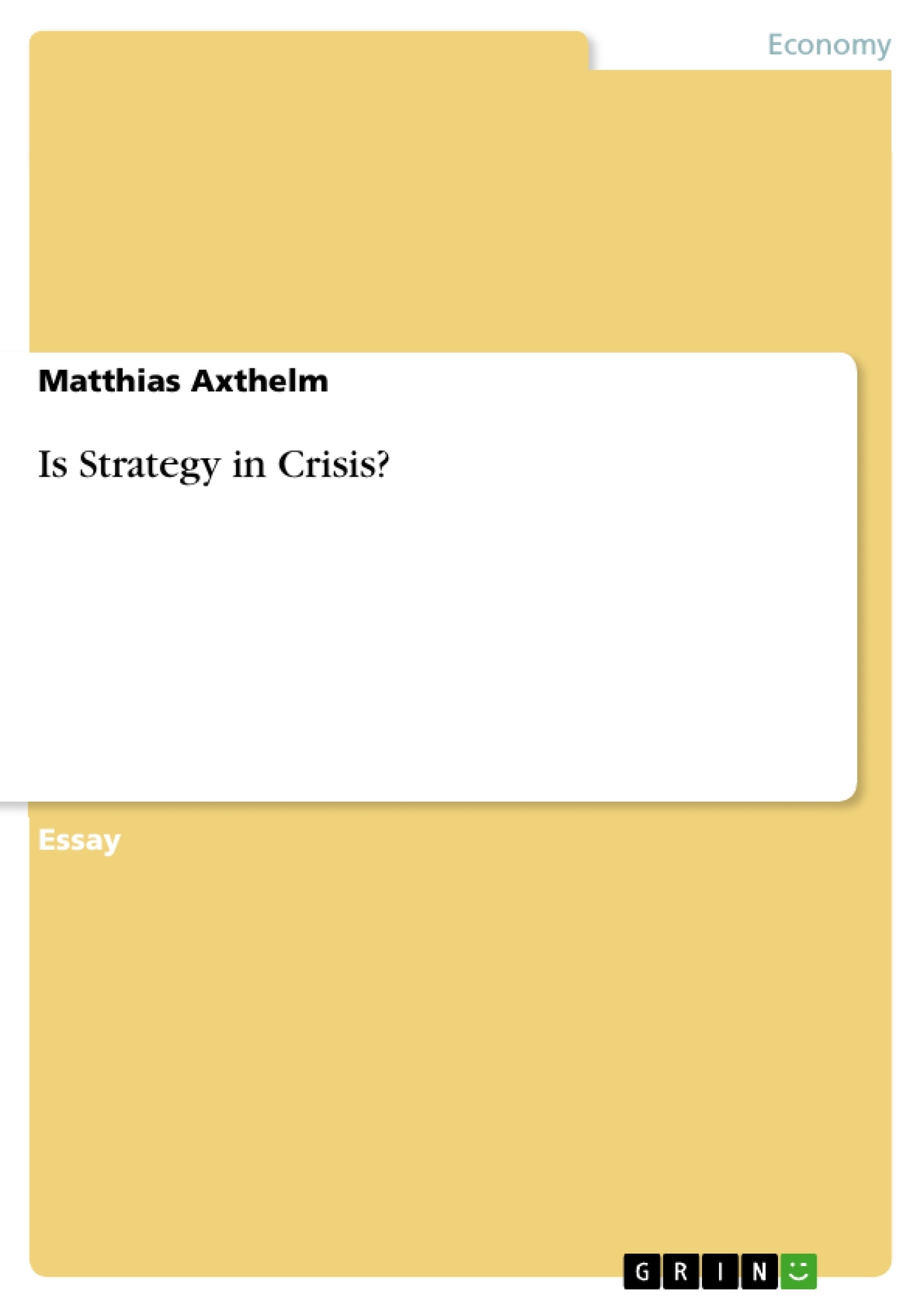This paper discusses the assertion that strategy is in crisis as Wilson and Jarzabkowski (2004) suggest. To come to this discussion, it is necessary to define the terms strategy and crisis. However, defining strategy is not straightforward. In fact, there is hardly any one who knows what strategy is (Markides, 2004). Even Porter (1987) recognises that there is not really an agreement about the definition of strategy. As a result, several, even opposing definitions shape the field of strategy (Whittington, 1996) as well as an accumulation of terms connected to strategy which are more confusing than claryfying (Markides, 2004). Mintzberg and Lampel (1999) for example, try to divide these different views into ten schools, whereas Johnson, Scholes and Whittington (2005) suggest that these approaches can be assembled with three lenses. Apart from the existing fields, there are also new ones emerging like the view of strategy as practice which focuses roughly speaking on the individuals in a company (Whittington, 2002). Nickols (2003) goes one step further. He claims that every definition and hence every approach has its right to exist, because strategy involves any of those definitions. Finally, Franklin (1998a) even questions the assumption whether strategy is an established paradigm, though it has been researched for many years...
Inhaltsverzeichnis (Table of Contents)
- Is corporate strategy in crisis?
- Definition of Strategy and Crisis
- Different Approaches to Strategy
- Resource-based view of strategy
- Porter's Five Forces
- Implementation and Structure
- The Model Trap
- Strategy as a Process of Creativity and Intuition
Zielsetzung und Themenschwerpunkte (Objectives and Key Themes)
This paper examines the claim that corporate strategy is in crisis, as proposed by Wilson and Jarzabkowski (2004). It explores the concept of strategy and crisis and analyzes different approaches to strategy, comparing them with the chosen definition and assessing whether they indicate a crisis in the field.
- Defining strategy and its various interpretations
- Exploring different approaches to strategy development and implementation
- Analyzing the challenges and complexities of strategic decision-making in a dynamic environment
- Evaluating the role of resources, competitive advantage, and environmental factors in strategy formulation
- Discussing the limitations of models and the importance of creativity and intuition in strategic thinking
Zusammenfassung der Kapitel (Chapter Summaries)
- The paper begins by defining strategy and crisis, emphasizing the lack of a universally agreed definition of strategy and its various interpretations. It then introduces a specific definition of strategy, focusing on achieving advantage through resource configuration and competence development.
- The paper examines the resource-based view of strategy, arguing that a firm's resources and their effective use form the basis for sustainable competitive advantage. Examples from the Czech Republic and Coca-Cola illustrate how valuable resources can enable firms to navigate environmental changes.
- Porter's Five Forces model is presented, focusing on the importance of analyzing the environment before making strategic decisions. Porter advocates for achieving a competitive advantage through differentiation or cost leadership, highlighting the importance of identifying and developing unique activities.
- The paper delves into the implementation of strategy, discussing the need for alignment between strategy and structure. It highlights challenges in implementation, including resource constraints, communication issues, and unclear instructions. Practical approaches like Kaplan and Norton's strategic maps are presented to improve implementation effectiveness.
- The paper explores the challenges of relying on models for strategic decision-making. It criticizes the assumption that a specific model is suitable for every situation, arguing that models may fail to capture critical factors influencing success and failure. The limitations of predicting future changes and the importance of creativity and intuition in strategic thinking are emphasized.
Schlüsselwörter (Keywords)
This paper focuses on the concept of corporate strategy, exploring various approaches and assessing its potential crisis. Key themes include strategy definition, resource-based view, competitive advantage, environmental analysis, implementation challenges, model limitations, and the importance of creativity and intuition in strategic decision-making.
- Quote paper
- Matthias Axthelm (Author), 2005, Is Strategy in Crisis?, Munich, GRIN Verlag, https://www.grin.com/document/51332



